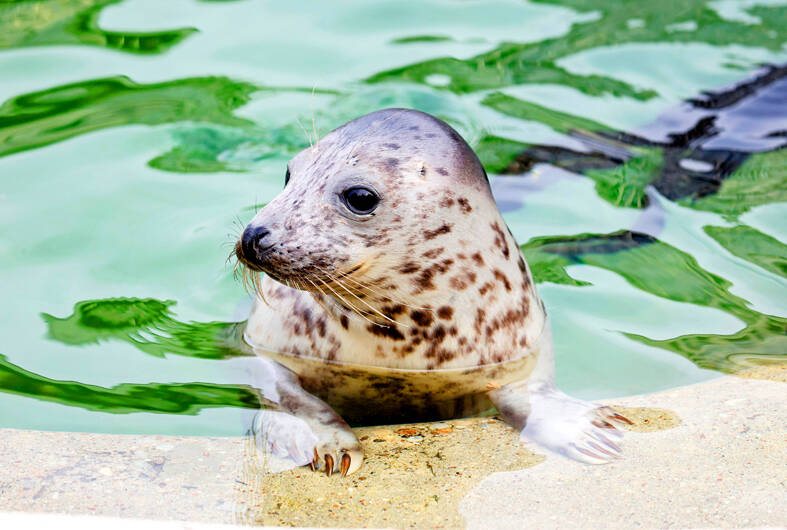The grey seals slide out of their cages into the Baltic Sea, swimming off to new lives imperilled by climate change, pollution and shrinking fish stocks.
The seals have been nurtured at a rehabilitation center in the Lithuanian port of Klaipeda.
Survival rates for cubs in the wild can be as low as 5 percent, local scientists said.

Photo: AFP
The Baltic Sea, which is shared by the EU and Russia, rarely freezes over now, depriving seals of sanctuaries to rear their cubs.
“Mothers are forced to breed on land in high concentration with other seals,” Vilnius University scientist Vaida Surviliene said. “They are unable to recognize their cubs and often leave them because of it.”
Rearing cubs ashore also leaves them exposed to humans, other wild animals, rowdy males and a higher risk of diseases, center biologist Arunas Grusas said.
Grusas began caring for seals in 1987, when he brought the first pup back to his office at the Klaipeda Sea Museum, which now oversees the new rehabilitation center.
“We taught them how to feed themselves, got them used to the water — they had to get comfortable with the sea, which spat them out ashore practically dying,” Grusas said.
The very first cubs were placed into makeshift baths set up in an office. The scientists had to learn how to nurse the cubs back to health.
In the late 1980s, the seals were close to extinction — there were just about 4,000 to 5,000 left in the sea from a population of about 100,000 before World War II.
“The population began to decrease drastically in the 1950s due to hunting amid competition with fishers,” Surviliene said.
The 1960s also saw the use of pesticides in agriculture that were “incredibly toxic for predators,” Surviliene said.
The seals at the top of the Baltic Sea food chain absorbed the pollution, leaving females infertile and the entire population with a weak immune system, unable to ward off parasites and resist infections.
After a ban on toxic pesticide use, the population survived, with the current estimates putting the number of grey seals in the Baltic Sea at 50,000 to 60,000.
In a response to overfishing, the European Commission also finally banned commercial cod fishing in the eastern Baltic Sea in 2019.
“Over 80 percent of fish resources in the Baltic Sea have been destroyed, the seals have nothing left to eat,” Grusas said.
The ban has yet to show a positive result.
“There has been no fishing of eastern Baltic cod for about five years, but it is not yet recovering — and it is one of the main sources of food” for the seals, Klaipeda University scientist Darius Daunys said.
Recently, a growing number of adult seals have been washing up on Lithuanian beaches.
Scientists such as Grusas point the finger at near-shore fishing nets, where seals desperate for food end up entangled and ultimately drown.
Out in the Baltic Sea, the nine released seals took their first swim in the wild.
Previously, GPS trackers showed they favored a route north toward the Swedish Gotland island in the middle of the Baltic Sea, where fish are more plentiful.
Others needed a gentle push from the biologists.
In previous years, the released seals would even follow the boat back to shore, scared to venture off alone.
Eventually they all find their way in the wild.